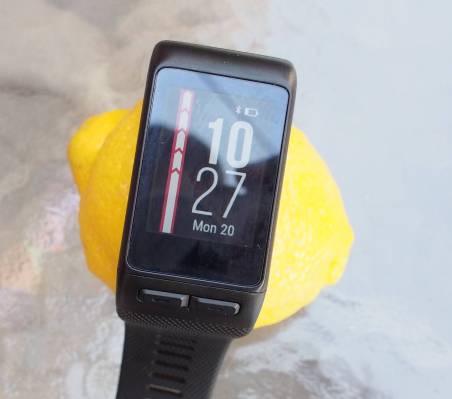There are a plethora of ways to track and improve your fitness, from a simple notebook to hiring a team of Crossfit coaches who will work your core until you scream. One of the most compact and capable methods, however, might be the vivoactive HR.
This $249 full-function GPS watch and heart rate tracker from Garmin is unique in that you’re supposed to wear it all the time. Not unlike a thinner, less obtrusive Fitbit or even the vivofit 3, the HR tracks your steps and activity but also can be used to track rowing, swimming, running, walking, indoor workouts, and even golf. Heck, you can even paddle board in this thing.
[gallery ids="1339705,1339703,1339702,1339701,1339699"]
The system connected with Garmin’s own application to store your workout data and can take your heart rate throughout the day. Most of the features are fire-and-forget – you select “Run” from the activities menu and then press a button to start the workout – but other features require you to pair your watch to your phone so you get see the weather as well as notifications. This is a health-minded smartwatch and, as such, it does a surprisingly admirable job of telling you what you need to know.
All the features!
To go through the entire feature list would be folly. The system can connect with Garmin’s bike cadence and speed sensors as well as Varia lights for automatic control. You can set up auto-lap systems to tell you how you’re doing and an built-in accelerometer lets you run or row indoors and out. Swimming with the watch give you a stroke count, speed, and “swolf” efficiency. The golfing feature lets you download maps and par statistics for thousands of courses around the world.
This means this is the one watch to rule all the sports, a bold move by Garmin. The company, which made its bones selling GPS units, has moved boldly into wearables and they’ve brought the ease-of-use and expertise associated with car GPS devices into their smartwatches. The styling is definitely a departure from their previous “bent bar of soap” Forerunner GPS devices and the vivoactive can easily stand in for a fashion-forward digital watch.
The watch is water-resistant to 5 ATM and includes a barometric altimeter and compass as well as GLONASS position sensing. Luckily most of the features are hidden behind an exceedingly simple interface that takes advantage of two bottom buttons to instigate actions and a simple, touch-sensitive on-screen menu system.
I couldn’t bring myself to wear it daily although I did strap it to my wrist for every run, eventually allowing it to replace my Apple Watch as my go-to run tracker. The battery lasts about a week, give or take, and it wasn’t unusual to find it flashing its green hear-rate sensor light while hidden at the bottom of my carry-on bag. You can lock the device or even turn it off but I rarely bothered and this didn’t seem to reduce the battery life by much.
Not so smartwatch
It’s in the smartwatch features, however, that Garmin slips up. The vivoactive is supposed to be a replacement for a Pebble or even an Apple Watch Sport. However, the features are quite limited. The notifications simply mirror the notifications on your lock screen and there is limited interaction between the watch and the phone (unless you count a clever “Find my phone” feature that forces your phone to buzz and beep.) There is a nice weather widget that shows you the current forecast and app syncing is seamless and pleasant. However don’t expect this to replace, say, an Android Wear device or an Apple Watch. The Bluetooth connectivity is a nice feature but not quite fully-baked.
Keeps you movin’
What the vivoactive is best at is giving you multiple sports and tracking systems in a tiny, wearable package. It’s meant to be worn daily so you truly have to decide if that’s something you want to do in order to take advantage of all of its features. If you’re looking for a running watch in particular the Forerunner line is intrinsically superior to this watch in terms of feature set alone. If you’re looking for an activity tracker, on the other hand, Fitbit and even Garmin offer superior and smaller products. The interesting thing is that Garmin is positioning the vivoactive as a successor to dedicated running devices, a move that could point to a decision to offer multi-sport devices rather than expensive single-sport systems.
I’ve slowly become a fan of the vivoactive after a few dozen miles on the road and a bit of swimming. There are plenty of devices simpler than this one and plenty of devices cheaper than $249. However, if you need a jack of all trades, a sort of Swiss Army smartwatch, that can track your golf, swimming, and running sessions and offers simple notifications then the vivoactive HR is definitely a contender.
